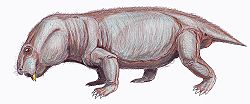| Emydorhynchus Temporal range: Late Permian | |
|---|---|
| Scientific classification | |
| Domain: | Eukaryota |
| Kingdom: | Animalia |
| Phylum: | Chordata |
| Clade: | Synapsida |
| Clade: | Therapsida |
| Suborder: | † Anomodontia |
| Clade: | † Dicynodontia |
| Family: | † Endothiodontidae |
| Genus: | † Emydorhynchus Broom, 1913 [1] |
| Species | |
Emydorhynchus formosusBroom, 1935 | |
Emydorhynchus is an extinct genus of endothiodont dicynodont, related to Endothiodon .





